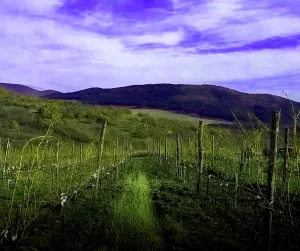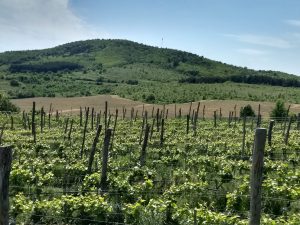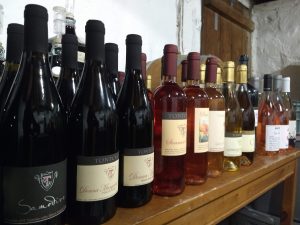January. 2019
It is imperative that we start building now the trellis and complete it by end of March 2019.
The vines were planted in April 2016 Their first summer was very dry - all the vines suffered - and few died. A very cold winter followed with temperatures into the -18C for several days. In spring it seemed that the vines had managed to survive. However, in the first days of May 2017 we’ve got two days of subzero temperatures. That resulted in completely killed shoots for the Nebbiolo, and up to 80% of the rest of the vines were severely injured. While only about half of the Nebbiolo came back, it took 40 days, the rest of the vineyard regrew in a couple of weeks almost unaffected. The growth during 2017 was still weak, because of the dry conditions, but installing a drip irrigation later in the season helped to some extent.
Season of 2018 – Nature treated us better than before. A rainy June-July helped the young vines get on their feet. Most vineyards complained about the wet summer, but hey, we come from the US East Coast where “Wet” is the norm. This is considered dry there. We loved it. Even the two hail storms that damaged plants and fruit could not take away the joy the water brought in.
There was a good growth.
Picked our first grapes – about 300 kg. Most of the vines grew very well. We’ll still have to prune back to two buds about 50% of the plants because of the hail damage. The rest needs posts and wires. NOW!
Building the trellis
As with anything else, we’ve got plenty of advices. The predominating words were – make it cheap and easy.
The cheap and easy advice included cement posts, wood posts with the asphalt or machine oil impregnated base or metal posts.
Of course, we won’t go for cheap and easy. We want to use plain wood. Black locust wood.
Plain wood will not last as much as impregnated wood – it will need replacement sooner than the oil, arsenic, copper, or other modern-wonders impregnated posts.
Metal may be of comparative cost, but again – where did it come from; how was is made, what would it release in the soil, and what was its energy footprint? There are no good answers to these.
The cement posts use metal and cement, and again have a too big of an energy imprint for our conscience to allow it.
What do the impregnated, metal, and cement posts release into the ground for the vines to absorb? It is not terroir.
So, while a plain piece of wood may seem to be cheaper and easier to use, it is more expensive in the long run. And believe it or not – in the contemporary economic system of planet-saving market and better-good oriented planning it is more difficult to find and buy a piece of plain wood post than a poisoned post. Here we are again marching uphill.
In late spring we called many of the wood cutting companies to ask for black locust. No wood, they said. Call in fall. In early summer we called all of the regional forest-management government agencies to find out where black locust can be found. Call in fall, they said. If fall they said – no black locust will be harvested.
In August we called companies in remote regions of BG to ask for black locust harvest. One of the companies said OK. “We stat harvesting in mid September. Give as a call then.” We called then and they said - “OK, we’ll have the posts for you in two weeks.” Great! It seemed like a deal. For whatever reason, in two weeks they delayed the sell with two weeks. And then with another week. And then with two more. So, by the end of November it was clear that they would not sell posts to use. They stopped answering calls from us. Typical on the hill.
The next black locust harvesting government allocation was going to happen in December. We started with the phone calls. Finally, in the first week of January 2019, the regional government agency gave us the names of two companies who got permits for black locust harvest.
The first of the companies said it finished harvesting black locust and all of it is cut in sizes for burning. Wow! It is a typical thing here in BG. They use strong, durable wood for burning. And they use pine for building things that should be durable – floors, furniture, and buildings. And mind it – that’s row, untreated pine.
The second company will let us know on the 15th whether they will be able to provide 500 pieces of 2.3 meter black locust.



